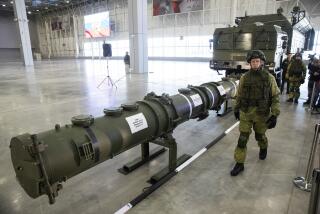Some Missile Defense Work Is Allowed, Clinton Lawyers Say
- Share via
WASHINGTON — Administration lawyers agree that President Clinton could approve the first steps toward building a national missile defense without violating a 1972 arms control treaty, Defense Secretary William S. Cohen said Wednesday.
The lawyers interpret the Anti-Ballistic Missile treaty as allowing preliminary construction work on a new X-band radar--a critical piece of a national missile defense--on Shemya Island, Alaska, up to the point where rails are laid for placement of the powerful missile-tracking radar on a concrete pad, Cohen said.
The rails are scheduled to be laid in 2002.
Clinton has not yet accepted his lawyers’ analysis. If he does, it would make it easier for him to give the Pentagon the go-ahead this year to award contracts for groundbreaking on Shemya, while letting the next president decide on the more advanced construction work that would breach the treaty.
Cohen said he expected Clinton to make that decision by September.
“As far as a technical breach of the ABM treaty, his decision in August or September would not constitute that, in our judgment,” Cohen said.
The timing of these decisions is important because the Pentagon has set a target date of 2005 for having a national missile defense ready for use. Any delay now would mean missing the target date.
Construction work on Shemya, in the Aleutian Islands, cannot start until next summer because of weather limitations.
Russia, which strongly opposes U.S. plans for a national missile defense, is certain to insist that any construction work on Shemya would constitute a violation of the treaty.
U.S. critics of a national missile defense question the administration’s interpretation of the ABM treaty.
“If they’re moving in the direction of a reinterpretation of the ABM treaty as meaning construction is not construction, I think that’s going to be hard to sustain,” said Daryl Kimball, executive director of the Coalition to Reduce Nuclear Dangers, an advocacy group opposed to national missile defense.
More to Read
Sign up for Essential California
The most important California stories and recommendations in your inbox every morning.
You may occasionally receive promotional content from the Los Angeles Times.













